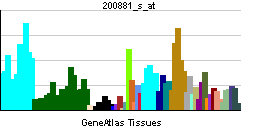DNAJA1
| DnaJ (Hsp40) homolog, subfamily A, member 1 | |||||||||
|---|---|---|---|---|---|---|---|---|---|
| Identifiers | |||||||||
| Symbols | DNAJA1 ; DJ-2; DjA1; HDJ2; HSDJ; HSJ2; HSPF4; hDJ-2 | ||||||||
| External IDs | Template:OMIM5 Template:MGI HomoloGene: 55588 | ||||||||
| |||||||||
| RNA expression pattern | |||||||||
 | |||||||||
 | |||||||||
| More reference expression data | |||||||||
| Orthologs | |||||||||
| Template:GNF Ortholog box | |||||||||
| Species | Human | Mouse | |||||||
| Entrez | n/a | n/a | |||||||
| Ensembl | n/a | n/a | |||||||
| UniProt | n/a | n/a | |||||||
| RefSeq (mRNA) | n/a | n/a | |||||||
| RefSeq (protein) | n/a | n/a | |||||||
| Location (UCSC) | n/a | n/a | |||||||
| PubMed search | n/a | n/a | |||||||
DnaJ (Hsp40) homolog, subfamily A, member 1, also known as DNAJA1, is a human gene.[1]
References
Further reading
- Chellaiah A, Davis A, Mohanakumar T (1993). "Cloning of a unique human homologue of the Escherichia coli DNAJ heat shock protein". Biochim. Biophys. Acta. 1174 (1): 111–3. PMID 8334160.
- Oh S, Iwahori A, Kato S (1993). "Human cDNA encoding DnaJ protein homologue". Biochim. Biophys. Acta. 1174 (1): 114–6. PMID 8334161.
- Kanazawa M, Terada K, Kato S, Mori M (1997). "HSDJ, a human homolog of DnaJ, is farnesylated and is involved in protein import into mitochondria". J. Biochem. 121 (5): 890–5. PMID 9192730.
- Davis AR, Alevy YG, Chellaiah A; et al. (1998). "Characterization of HDJ-2, a human 40 kD heat shock protein". Int. J. Biochem. Cell Biol. 30 (11): 1203–21. PMID 9839446.
- Pei L (1999). "Pituitary tumor-transforming gene protein associates with ribosomal protein S10 and a novel human homologue of DnaJ in testicular cells". J. Biol. Chem. 274 (5): 3151–8. PMID 9915854.
- Meacham GC, Lu Z, King S; et al. (1999). "The Hdj-2/Hsc70 chaperone pair facilitates early steps in CFTR biogenesis". EMBO J. 18 (6): 1492–505. doi:10.1093/emboj/18.6.1492. PMID 10075921.
- Terada K, Mori M (2000). "Human DnaJ homologs dj2 and dj3, and bag-1 are positive cochaperones of hsc70". J. Biol. Chem. 275 (32): 24728–34. doi:10.1074/jbc.M002021200. PMID 10816573.
- Jana NR, Tanaka M, Wang G, Nukina N (2000). "Polyglutamine length-dependent interaction of Hsp40 and Hsp70 family chaperones with truncated N-terminal huntingtin: their role in suppression of aggregation and cellular toxicity". Hum. Mol. Genet. 9 (13): 2009–18. PMID 10942430.
- Ohtsuka K, Hata M (2001). "Mammalian HSP40/DNAJ homologs: cloning of novel cDNAs and a proposal for their classification and nomenclature". Cell Stress Chaperones. 5 (2): 98–112. PMID 11147971.
- Bao YP, Cook LJ, O'Donovan D; et al. (2002). "Mammalian, yeast, bacterial, and chemical chaperones reduce aggregate formation and death in a cell model of oculopharyngeal muscular dystrophy". J. Biol. Chem. 277 (14): 12263–9. doi:10.1074/jbc.M109633200. PMID 11796717.
- Hernández MP, Chadli A, Toft DO (2002). "HSP40 binding is the first step in the HSP90 chaperoning pathway for the progesterone receptor". J. Biol. Chem. 277 (14): 11873–81. doi:10.1074/jbc.M111445200. PMID 11809754.
- Imai Y, Soda M, Hatakeyama S; et al. (2002). "CHIP is associated with Parkin, a gene responsible for familial Parkinson's disease, and enhances its ubiquitin ligase activity". Mol. Cell. 10 (1): 55–67. PMID 12150907.
- Strausberg RL, Feingold EA, Grouse LH; et al. (2003). "Generation and initial analysis of more than 15,000 full-length human and mouse cDNA sequences". Proc. Natl. Acad. Sci. U.S.A. 99 (26): 16899–903. doi:10.1073/pnas.242603899. PMID 12477932.
- Hanai R, Mashima K (2004). "Characterization of two isoforms of a human DnaJ homologue, HSJ2". Mol. Biol. Rep. 30 (3): 149–53. PMID 12974469.
- Lehner B, Semple JI, Brown SE; et al. (2004). "Analysis of a high-throughput yeast two-hybrid system and its use to predict the function of intracellular proteins encoded within the human MHC class III region". Genomics. 83 (1): 153–67. PMID 14667819.
- Bouwmeester T, Bauch A, Ruffner H; et al. (2004). "A physical and functional map of the human TNF-alpha/NF-kappa B signal transduction pathway". Nat. Cell Biol. 6 (2): 97–105. doi:10.1038/ncb1086. PMID 14743216.
- Marschang P, Brich J, Weeber EJ; et al. (2004). "Normal development and fertility of knockout mice lacking the tumor suppressor gene LRP1b suggest functional compensation by LRP1". Mol. Cell. Biol. 24 (9): 3782–93. PMID 15082773.
- Gerhard DS, Wagner L, Feingold EA; et al. (2004). "The status, quality, and expansion of the NIH full-length cDNA project: the Mammalian Gene Collection (MGC)". Genome Res. 14 (10B): 2121–7. doi:10.1101/gr.2596504. PMID 15489334.
- Rush J, Moritz A, Lee KA; et al. (2005). "Immunoaffinity profiling of tyrosine phosphorylation in cancer cells". Nat. Biotechnol. 23 (1): 94–101. doi:10.1038/nbt1046. PMID 15592455.
- Hu Y, Zhou Z, Huang X; et al. (2005). "Expression of a novel DnaJA1 alternative splicing in human testis and sperm". Int. J. Androl. 27 (6): 343–9. doi:10.1111/j.1365-2605.2004.00492.x. PMID 15595953.
| This protein-related article is a stub. You can help Wikipedia by expanding it. |